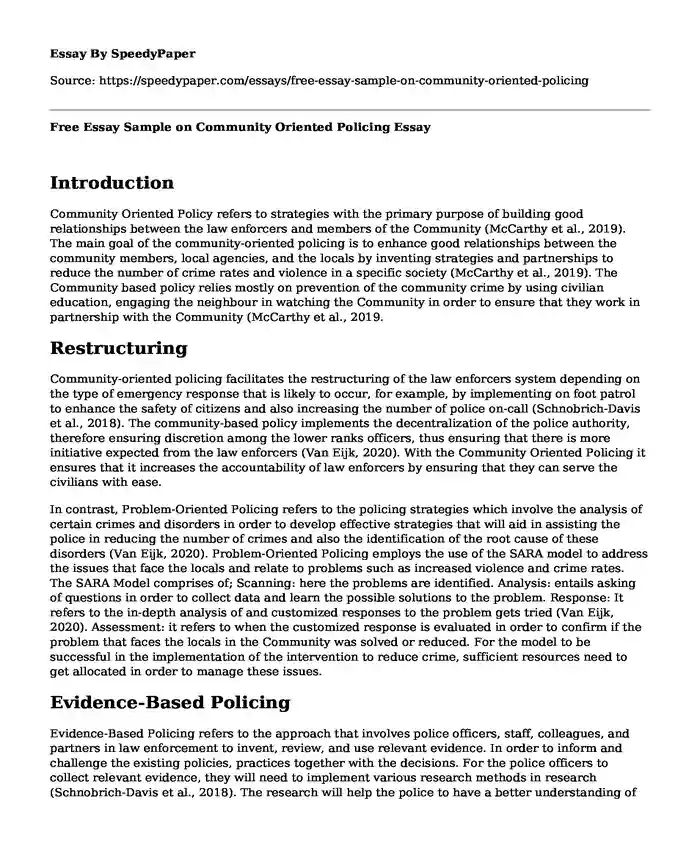
| Type of paper: | Essay |
| Categories: | Community Policy analysis |
| Pages: | 3 |
| Wordcount: | 660 words |
Introduction
Community Oriented Policy refers to strategies with the primary purpose of building good relationships between the law enforcers and members of the Community (McCarthy et al., 2019). The main goal of the community-oriented policing is to enhance good relationships between the community members, local agencies, and the locals by inventing strategies and partnerships to reduce the number of crime rates and violence in a specific society (McCarthy et al., 2019). The Community based policy relies mostly on prevention of the community crime by using civilian education, engaging the neighbour in watching the Community in order to ensure that they work in partnership with the Community (McCarthy et al., 2019.
Restructuring
Community-oriented policing facilitates the restructuring of the law enforcers system depending on the type of emergency response that is likely to occur, for example, by implementing on foot patrol to enhance the safety of citizens and also increasing the number of police on-call (Schnobrich-Davis et al., 2018). The community-based policy implements the decentralization of the police authority, therefore ensuring discretion among the lower ranks officers, thus ensuring that there is more initiative expected from the law enforcers (Van Eijk, 2020). With the Community Oriented Policing it ensures that it increases the accountability of law enforcers by ensuring that they can serve the civilians with ease.
In contrast, Problem-Oriented Policing refers to the policing strategies which involve the analysis of certain crimes and disorders in order to develop effective strategies that will aid in assisting the police in reducing the number of crimes and also the identification of the root cause of these disorders (Van Eijk, 2020). Problem-Oriented Policing employs the use of the SARA model to address the issues that face the locals and relate to problems such as increased violence and crime rates. The SARA Model comprises of; Scanning: here the problems are identified. Analysis: entails asking of questions in order to collect data and learn the possible solutions to the problem. Response: It refers to the in-depth analysis of and customized responses to the problem gets tried (Van Eijk, 2020). Assessment: it refers to when the customized response is evaluated in order to confirm if the problem that faces the locals in the Community was solved or reduced. For the model to be successful in the implementation of the intervention to reduce crime, sufficient resources need to get allocated in order to manage these issues.
Evidence-Based Policing
Evidence-Based Policing refers to the approach that involves police officers, staff, colleagues, and partners in law enforcement to invent, review, and use relevant evidence. In order to inform and challenge the existing policies, practices together with the decisions. For the police officers to collect relevant evidence, they will need to implement various research methods in research (Schnobrich-Davis et al., 2018). The research will help the police to have a better understanding of the underlying issue in that they will have a deeper understanding of the course of the problem, and therefore, they will be able to assess and implement on the best policing intervention that would be of great aid to the police department (Schnobrich-Davis et al., 2018).
Conclusion
In contrast, Risk-Based Policing refers to advancement in research in order to manage the increased rate of criminal activities and therefore enhance public safety (Van Eijk, 2020). In the risk-based policy, it focusses on uses the theories of risky places to locate areas that are prone to criminal activities, and therefore the police will be able to create a haven for the locals.
References
McCarthy, M. M., Porter, L. E., Townsley, M., & Alpert, G. P. (2019). The effect of community-oriented policing on police use of force: Does community matter? Policing: An International Journal, 42(4), 556-570. https://doi.org/10.1108/pijpsm-10-2018-0148
Schnobrich-Davis, J., Block, S., & Lupacchino, J. (2018). Analysis of Herman Goldstein problem-oriented policing awards from 1993-2017. Policing: A Journal of Policy and Practice, 14(3), 616-629.
https://doi.org/10.1093/police/pay046
Van Eijk, G. (2020). Inclusion and exclusion through risk-based justice: Analysing combinations of risk assessment from pretrial detention to release. The British Journal of Criminology, 60(4), 1080-1097. https://doi.org/10.1093/bjc/azaa012.
Cite this page
Free Essay Sample on Community Oriented Policing. (2023, Nov 24). Retrieved from https://speedypaper.net/essays/free-essay-sample-on-community-oriented-policing
Request Removal
If you are the original author of this essay and no longer wish to have it published on the SpeedyPaper website, please click below to request its removal:
- What is Unique about Rural Aging. Paper Example
- Paper Example. Scope of Practice for an APN
- Essay Sample: The Role of Sustainable Interior Design in Nigeria's Economy
- Free Essay: A short history of Indians in Canada
- Paper Example - Theoretical Journal: Symbolic Interactionism
- Essay Sample on Role of the Professional Nurse in Health Policy
- Paperless Work Environment - Free Paper Sample
Popular categories




